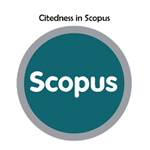The Effect of Patikan Kebo (Euphorbia hirta) Herbal Extract on Collagen Levels in the Kidney and Heart of Fibrotic Rats
Abstract
Noncommunicable diseases (NCDs) are the leading cause of death worldwide. There are around 36 million deaths every year. An example of NCD, a non-communicable disease, is hypertension. Excessive consumption of sodium chloride (NaCl) is the main factor that can cause hypertension and organ fibrosis. A natural ingredient that has the potential to act as an antifibrosis agent against fibrosis is quercetin by increasing PPAR-γ expression. Based on research, one of the plants that contains quercetin is the herb of Patikan Kebo (Euphorbia hirta Linn). Collagen is a protein biomarker of fibrosis synthesized via the PPAR-γ signaling pathway. The aim of this research was to determine the organ protective effect of administration of Patikan Kebo herbal extract against renal fibrosis and heart in Wistar rats (Rattus norvegicus) induced with 1.5% NaCl. The method involved 15 male Wistar rats aged 2.5 months with a body weight of 100-150 grams, which were divided into three groups (KI: control; KII: induced by 1.5% NaCl; KIII: induced by 1.5% NaCl + Patikan Kebo extract 200 mg/kg body weight. The induction was carried out for 8 consecutive weeks. On day 56, the kidneys and heart were removed in groups I and II, while in group III the treatment with the Patikan-Kebo extract from Patikan-Kebo at a dose of 200 mg/kg body weight was continued for 28 days in Group III. Specifically, for group III, kidneys and heart were collected on day 84 after treatment with Patikan kebo extract on day 84. Collagen was stained with Giemsa stain. Data were analyzed using a Kruskal-Wallis test. The difference is considered significant if the probability value is p<0.05. The result showed that there were significant differences between the control and treatment groups. Patikan Kebo extract can reduce collagen in rats with induced fibrosis with 1.5% NaCl.
Keywords
Full Text:
PDFReferences
WHO. Global status report on non-communicable maladys. Geneva: Switzerland; 2010
Baltatzi, MCH.S., Hatzitolios A. Role of angiotensin converting enzyme inhibitors and angiotensin receptor blockers in elevated blood pressure of chronic renal organ malady and renoprotection. Hippokratia. 2011; 15: 2732.
Blaustein, MP., et al. How NaCl raises blood pressure: A new paradigm for the pathogenesis of saltdependent elevated blood pressure. Am J Physiol Heart Circ Physiol. 2012; 302: H1031-H1049.
Cox, N., Pilling, D., Gomer, RH. NaCl potentiates human fibrocyte differentiation. PLoS One. 2012; 7: 1-9.
Beevers, G., Lip, GYH,, O'Brien, E. ABC of elevated blood pressure: "The pathophysiology of elevated blood pressure". BMJ. 2001; 322: 912-916.
He, FJ., Jenner, KH., MacGregor, GA., Avenue, G. Telmisartan exerts renoprotective actions via peroxisome. Elevated blood pressure. 2012; 59: 308-316.
Meneton, P., et al. Links between dietary salt intake, renal salt handling, blood pressure and cardiovascular maladys. Physiol Rev. 2005; 86: 679-715.
Yu, HCM, Burrell, LM., Black, MJ., Wu, LL., Dilley, RJ. Salt induces myocardial and renal fibrosis in normotensive and hypertensive rats. Circulation. 1998; 98: 2621-2628.
Leenen, FHH. The central role of the brain aldosterone - "ouabain" pathway in salt-sensitive elevated blood pressure. BBA Mol Basis Dis. 2010; 1802: 1132-1139.
Jöhren, O., Dendorfer, A., Dominiak, P. Cardiovascular and renal function of angiotensin II type-2 receptors. Cardiovasc Res. 2004; 62: 460-467.
Starr, C., McMillan, B. Human Biology. 9th Edn, Brooks/Cole Cengage Learning, Canada; 2012.
Mezzano, SA., Ruiz-Ortega, M., Egido, J. Angiotensin II and renal fibrosis. Elevated blood pressure. 2001; 38: 635638.
Chambers, S., Schachter, M., Morrell, J., Gaw, A., Kirby, M. Telmisartan an effective anti-hypertensive for 24 h blood pressure control. Drugs in Context. 2008; 4: 1-14.
Funao, K., et al. Telmisartan as a peroxisome proliferatoractivated receptor - Ã ligand is a new target in the treatment of human renal cell carcinoma. Mol Med Rep. 2009; 2: 193-198.
Rotman, N., Wahli, W. PPAR modulation of kinase-linked receptor signaling in physiology and malady. Physiology. 2010; 25: 176-185.
Greenwood, M., Greenwood, M.P., Paton, J.F., Murphy, D. Transcription Factor CREB3L1 Regulates Endoplasmic Reticulum Stress Response Genes in the Osmotically Challenged Rat Hypothalamus.. PloS one. 2015; 10(4):e0124956.
Cao, W., Li, A., Wang, L., Zhou, Z., Su, Z., Bin, W., et al. A Salt-Induced Reno-Cerebral Reex Activates ReninAngiotensin Systems and Promotes CKD Progression. Journal of the American Society of Nephrology : JASN. 2015; 26(7):1619-33.
Tanada, Y., Okuda, J., Kato, T., Minamino-Muta, E., Murata, I., Soga, T., et al. The metabolic prole of a rat model of chronic kidney disease. PeerJ. 2017; 5:e3352. Page 11/15
Hijmans RS, Shrestha P, Sarpong KA, Yazdani S, El Masri R, de Jong WHA, et al. High sodium diet converts renal proteoglycans into pro-inammatory mediators in rats. PloS one. 2017;12(6):e0178940.
Washino, S., Hosohata, K., Jin, D., Takai, S., Miyagawa, T. Early urinary biomarkers of renal tubular damage by a high-salt intake independent of blood pressure in normotensive rats. Clin Exp Pharmacol Physiol. 2018; 45(3):261-8.
Shang, Q.H., Min, X.Q., Liu, C., Mao, W.H., Shang, Q.H. Effects of high salt diet on arterial remodelling and the intervention of telmisartan in wistar rats. Heart. 2012; 98: E1-E319.
DOI: https://doi.org/10.37311/ijpe.v5i1.28940
Refbacks
- There are currently no refbacks.
Copyright (c) 2025 Adelia Riezka Rahim, Khairil Pahmi, Musanip Musanip, Lalu Sahrul Hudha, Eva Triani, Amran Halim

Indonesian Journal of Pharmaceutical Education is licensed under a Creative Commons Attribution-NonCommercial-ShareAlike 4.0 International License.




